

By
Don and Linda Freedman
Search TheTravelzine
TheTravelzine Group
Access Your Mail
Don's Gallery
Packing Hints
Planning Tips
Cities Links
Links
LINKS
TO OUR TRAVELOGUES
Argentina, Buenos Aires - Jan-Mar 2010
Argentina, Buenos Aires - Jan-Mar 2009
Argentina, Buenos Aires - Jan-Mar 2008
Austria - Fall 2005
Belgium, Brussels - Fall 2000
Canada - Summer 2002
Canada - Summer 2001
Canada - Summer 2000
Czech Republic - Spring 2000
France - Fall 2002
France, Paris - Fall 2000
France, Paris - Spring 1999
France, Lyon - Spring 1999
Germany, Berlin - Fall 2009
Germany - Fall 2002
Germany - Spring 2000
Germany - Fall 1999
Greece - Fall 2012
Greece - Fall 1999
Greece - Fall 1997
Hungary - Spring 2000
Israel - Fall 1999
Italy - Winter 2007
Italy - Winter 2006
Italy - Winter 2005
Italy - Winter 2004
Italy - Winter 2003
Italy - Winter 2001
Italy - Fall 1998
Italy - Fall 1996
Netherlands - Spring 2000
Portugal, Azores - 2019
Portugal, Azores - 2018
Portugal, Sao Miguel & Lisbon - 2017
Portugal, Azores - 2017
Portugal, Azores - 2016
Portugal, Azores - 2015
Portugal, Azores - 2014
Portugal, Azores - 2013
Portugal, Azores - 2012
Portugal, Azores - 2011
Portugal, Lisbon - 2011
Portugal - Fall 2006
Portugal - Fall 2004
Portugal - Fall 2003
Portugal - Fall 2001
Portugal - Spring 1999
Portugal - Spring 1997
Slovakia - Spring 2000
Slovenia - Spring 1999
Slovenia - Fall 1996
Spain, Barcelona - Winter 2006
Switzerland - Fall 2002
Switzerland - Spring 2000
Switzerland - Spring 1999
Switzerland - Fall 1998
Switzerland - Fall 1997
Switzerland - Spring 1996
U.S. Florida, Key West - Fall 2006
U.S. Florida - Spring 2001
U.S. Maine - Summer 2002
U.S. Massachusetts - Summer 2003
U.S. Massachusetts - Summer 2002
U.S. Massachusetts - Summer 2001
U.S. New York State - Fall 2005
U.S. New York State - Summer 2004
U.S. New York State - Summer 2003
U.S. New York State - Summer 2001
U.S. Washington,DC - Spring 2000
PORTUGAL
WINTER 2012
Part One | Part Two | Part Three
SAO MIGUEL, AZORES
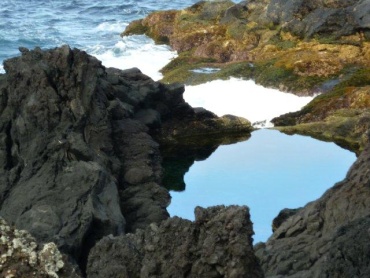
Another day Helena guided us furthur west along the southern coast to Ponta da Ferraria and Mosteiros. Our first stop was at Miradouro Escalvado, a former lookout post for sperm whales which supported the whaling industry of Mosteiros. High above the blue sea the air is exhilarating. We were overwhelmed, where to look first - the rock formations along the coast, the fertile grazing lands (with cows), the town of Mosteiros in the distance, the volcanic cone of Camarinhas jutting up from the sea? We lingered, absorbing the beauty and serenity.
Mosteiros is an extremely attractive village with its old homes, fishing port and thermal springs. There is a deep bay with four small islands rising up in pointed shapes. The beach opposite and the natural pools between basalt lava make it a summer favorite. In the pretty Praca de Sao Lazaro we spotted three village ladies sitting on a bench. It was a dream scene. Linda asked them if they would mind if she photographed them. You never saw senior ladies move so fast adjusting their clothing, fixing their hair and posing like professionals. They were adorable. In another nearby square four gentlemen were also pleased to pose and were equally as charming as the ladies.
Another great stop is Merendario e
Miradouro do Caminho Velho. Besides marvelous views of
the coastline there is a comfortable barbecue and picnic
area. Just pack your choriso and charcoal. There are
areas like this throughout the island, at many viewpoints
and along the roads. All are well kept with barbecues,
tables and benches, lovely surroundings and some with
facilities.
[Back
to To]
Ponta da Ferraria has a famous lighthouse which was built in 1901 in a traditional modern style with lovely well kept grounds. Three families live, work and maintain the facility. Down below we could see natural swimming pools carved into the basalt filled with frolicking bathers. We took the winding steep drive down to the thermal bath facility. There is an attractive main building that services patrons along with a restaurant. A large thermal pool is to the rear and a long pathway and staircase leads to the natural pools. It's a neat place to soak, relax and heal.
The lakes of Sao Miguel are the most visited sites of the island. We have written about them extensively in previous travelogues but the experience is so exhilarating we must touch on it again. It is not just the incredible beauty of the lakes and their environs but the journey along the lush green and flowered roads to get there and the majestic views along the way.
The lakes of Sete Cidades are in the western part of the island. Start at the viewpoints high above the green and blue lakes (two neighboring lakes, whose color differential has faded a bit in time) and be awestricken by the mystical waters and the surrounding landscape. Your reverie will end and it will be time to go down to see the waters up close and appreciate the "legends" (see previous travelogues) of Sete Cidades. Wander through the enchanting Village of Sete Cidades and enjoy lunch at any of the numerous restaurants. This trip we enjoyed the buffet at Lago Azul. Needless to say we did not have dinner after repeatedly filling our plates with fish, beef, pork, fresh and cooked vegetables all washed down with beer.
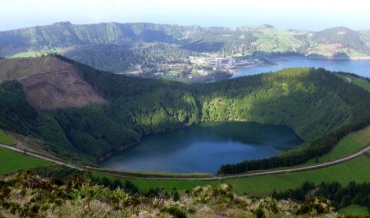 In contrast to the
size and scope of these two lakes is the exquisite small
Lagoa de Santiago. From the viewpoint above, it is a WOW
moment. There's a bowl of green surrounding the stunning
waters. The intial impulse is to leap over the low wall
and dive in, float around and be entranced by the packed
green trees and blue sky.
In contrast to the
size and scope of these two lakes is the exquisite small
Lagoa de Santiago. From the viewpoint above, it is a WOW
moment. There's a bowl of green surrounding the stunning
waters. The intial impulse is to leap over the low wall
and dive in, float around and be entranced by the packed
green trees and blue sky.
Logoa do Fogo (Fire Lake) sits atop
the 947m high Serra de Agua de Pau in the center of the
island. Halfway up is paradise, caldeira Velha, a "Natural
Regional Monument". A stunning pathway lined with a
huge variety of dense vegetation leads to the steamy
bubbling waters of the hot springs. The profuse
vegetation leads to a waterfall tumbling into a large
natural pool occupied by bathers in the soothing waters.
Caldeira Velha is a natural wonder not to be missed.
[Back
to To]
Photo ops abound as you work your way round and round to the top of the crator where Lagoa do Fogo greets you in all its glory. A myriad of shades of greens surround the blue waters which constantly change in hue. At the bottom is a small tree-covered peninsula and areas of white sand beaches. Another jewel of nature. The journey down offers a panorama of the western island, the sparkling ocean, deep valleys and the ever-present green pastures and grazing cows.
To the east is Lagoa da Furnas, 281m above sea level, reflecting the beach trees and cryptomerias surrounding it. The smell of sulphur and steam rising from the ground will lead you to the nearby "calderas". Bubbling waters rise from the bare dark earth. Holes are dug to accommodate the large pots of meat and vegetables for cooking the famous "Cozido das Furnas". The pots are wrapped in bags and buried for 5 to 6 hours. The subterranean heat produces a unique flavor that can not be duplicated.
There are two viewpoints over Lagoa das Furnas that offer spectacular panoramas. Pico do Ferro offers two views, one of the lake and the other the crator itself and the white houses of the village. Salto do Cavalo at 805m provides dazzling views from Lagoa da Furnas to the blue sea of the northeast coast and west to Serra de Aqua de Pau, the mountain that conceals Lagoa do Fogo.
We journeyed to Furnas for a Camelia exhibition in the Casino of the Hotel Terra Nostra. Who knew that this flower came in so many colors? The displays were beautifully done and cameras were humming.
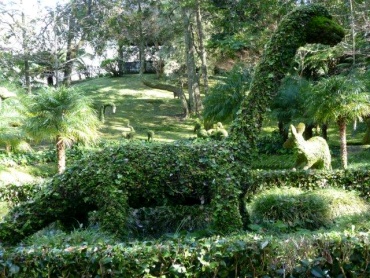 Behind the hotel
is the wonderous garden, Parque Terra Nostra. Colorful
flowered paths lead you through a collection of age old
trees and plantings. Swans find a home in the lakes
winding their way around the garden. Local yams with
their wide green leaves grow on the banks of a warm
stream. It was a warm sunny day perfect for this trip
through the beauty of nature.
Behind the hotel
is the wonderous garden, Parque Terra Nostra. Colorful
flowered paths lead you through a collection of age old
trees and plantings. Swans find a home in the lakes
winding their way around the garden. Local yams with
their wide green leaves grow on the banks of a warm
stream. It was a warm sunny day perfect for this trip
through the beauty of nature.
Nature is unleashed in the center of Furnas. Caldeira Grande and Caldeira de Pero Botelho, which names evoke the depths of hell, join others to create a group of volcanic manifestations. These springs emerge near the calderas and the banks of the Tambores stream sprouting geysers of steaming bubbling water. Are we on Mars? You decide.
The "Parque Florestal",
Forestry Commission, operates a plant and vegetable
nursery that supplies basic product for private and
public gardens. Aquatic tanks breed trout which are used
to to replenish the lakes and rivers of the island.
[Back
to To]
Bolos levedos look like a large English muffin. They are more dense and tastier. Receita da Vida at Rua Victor Manual Rodrigues, 16 in Furnas is a leading producer of this habit-forming goodie. The delightful ladies were taking handfuls of the mixed dough from a giant vat, hand forming and placing them on a large flat grill. After a short period they were flipped over and when done piled up ready for packaging. They are packed 5 to a pack and can be found in shops all over the island. They are delicious and when topped with jams from Quintal dos Acores, heavenly.
Back in Ponta Delgada Helena's Joao led us to another new treat, Pinhal da Paz or Mata das Criações, Recreational Forest Reserve, in the parish of Faja de Cima not too far from the city center. It covers an area over 120 acres. Painted tiles describe the trees, plants, and flora that inhabit the grounds. A large picnic area with grills and tables along with playgrounds, sport areas and washroom facilities make it a splendid family destination. A large fenced area houses fallow deer. Lots of room to roam and if you are in the mood to entertain, there is a stage for performances and cultural activities. A few peacocks, pheasants and guinea fowl are on display and a lake with friendly swans beckons. What a find!
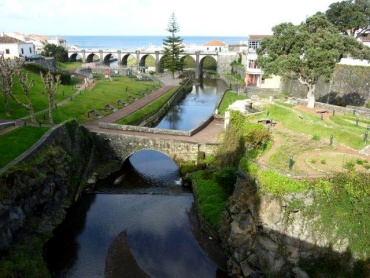 Ribeira Grande is the second largest city of
Sao Miguel. It is located in the middle of the northern
coast. The city got its name from the river that flows
from Lagoa do Fogo through the city center to the ocean.
Standing in Largo 5 de Outubro and looking north you can
follow the scenic course of the river. The stunning Town
Hall sits amidst colorful gardens on the banks of the
river. In the distance a striking bridge with high arches
crosses the river as it nears the end of its journey
between the exquisite coastline of pebbled beaches and
natural swimming pools.
Ribeira Grande is the second largest city of
Sao Miguel. It is located in the middle of the northern
coast. The city got its name from the river that flows
from Lagoa do Fogo through the city center to the ocean.
Standing in Largo 5 de Outubro and looking north you can
follow the scenic course of the river. The stunning Town
Hall sits amidst colorful gardens on the banks of the
river. In the distance a striking bridge with high arches
crosses the river as it nears the end of its journey
between the exquisite coastline of pebbled beaches and
natural swimming pools.
[Back
to To]
We had the good fortune to visit Ceramica Micaelense, Rua do Rosario, 42 in the parish of Matriz. The highlight was watching two incredible artists at work. One was painting the name and dates on finished products using a thin brush moving with the speed of light writing one line after the other in perfectly crafted script. The other artist was painting a large panel of tiles from a photograph with flawless strokes as a masterpiece was emerging. This was for a special order, a specialty of Micaelense, for clients around the world. Their basic products can be found in gift and souvenier shops in all of Portugal.
The seaside village of Maia is along the north coast east of Ribeira Grande, where we found a perfect place for lunch at Restaurante Grao d Areia. The village has an active fishing port which insures you will always find the catch of the day available. The simple family atmosphere was alive with locals relishing their overflowing plates of home cooking. We were warmly greeted and seated - immediately feeling part of the scene. The plates of the day were broken down by three price points: 4.99, 5.99 and 7.50 Euros. The owner suggested the fresh caught cherne, which is our favorite. The house-made bread and fresh cheese kept us occupied until we were served the huge filets which were perfectly grilled and seasoned with garlic and piri piri and served with boiled potatoes, rice and salad. Homemade natas sprinkled with cinnamon and coffee were a fine finish. It does not get better than Grao d Areia.
Bread and rolls are the mainstay of
every meal. They are produced in a variety of places from
people's homes to cooperatives. East of Maia is the
pretty town of Salga where we stopped at Maos de Pada,
Rua Direita, 32, a cooperative since 1995. A large truck
was unloading wood to be used in the wood burning ovens.
Two types of bread, the typical crusty wheat flour and a
dense corn had just come out of the oven. We opted for
one of each. Be warned the corn version is not just dense,
it is extremely dense, and the crust is very thick -
tough to cut without sharp knives for that purpose.
Visitors are welcome to watch the process and buy the
beauties coming out of the ovens at that time.
[Back
to To]
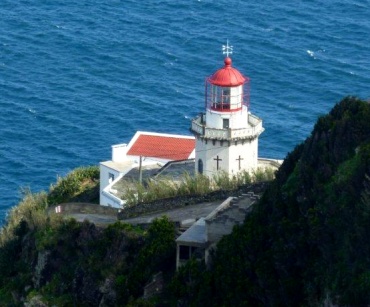 Povoacao, on the
southeastern coast, is a favorite destination. The pretty
town square with its Zoo, busy cafes, and neat shops are
reason enough to visit. Since this lovely town is the
originator of "fofas" you can test the
varieties in each of the cafes. Getting back to bread and
rolls, find your way to, "Duvenalia"(the owners
name), watch the friendly ladies do their thing and buy
the best. Also, find your way to Cantinho do Churrasco by
the waterfront for a feast of grilled lulas and frango.
Povoacao, on the
southeastern coast, is a favorite destination. The pretty
town square with its Zoo, busy cafes, and neat shops are
reason enough to visit. Since this lovely town is the
originator of "fofas" you can test the
varieties in each of the cafes. Getting back to bread and
rolls, find your way to, "Duvenalia"(the owners
name), watch the friendly ladies do their thing and buy
the best. Also, find your way to Cantinho do Churrasco by
the waterfront for a feast of grilled lulas and frango.
Along the shore east of Ponta Delgada are the villages of São Roque and Lagoa. The rocky shoreline, pristine beaches and fine restaurants and clubs are a favorite destination for locals and visitors. Joao and Helena introduced us to Boca da Furna, Rua do Terreiro, 53, a rough and ready bar with game rooms and a patio over the sea. They also dish out the best steak and eggs and french fries at a price that keeps you coming back. Please keep it a secret.
Our friend Ana often walks from Ponta Delgada to Lagoa and on one of her excursions discovered O Rabaca, Rua do Porto, 1, Rosario-Lagoa, in front of the fish port. She was kind enough to drive us one day for lunch. This typical waterfront neighborhood eatery was a delight. The proprietress and some of the diners instantly recognized Ana and it was like old home week. We shared a table with a few gentlemen one of whom remembered seeing us at the Night of the Stars celebration in Relva - small world. We feasted on great bread and cheese, conchas or lapa burro (like mussels) with lots of garlic, fried chicharros, veal steak, rice pudding and fried dough (like a donut). A truly fun time.
As we left our perch high above the
Atlantic for the airport and our Sata flight home, we
knew the warm memories of our friends and the island
would be with us until we return in 2013.
For additional information visit the website of the Azores.
Part One | Part Two | Part Three
Search TheTravelzine | TheTravelzine Group | Don's Gallery
Packing Hints | Planning
Tips | Cities
Links
All pages on TheTravelzine.com©Copyright 1996-2020 Don & Linda Freedman